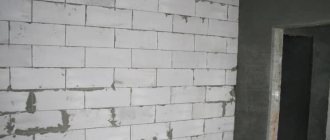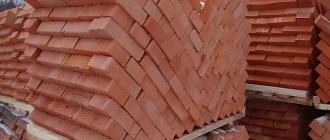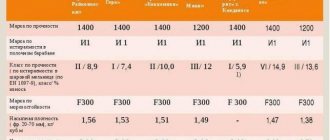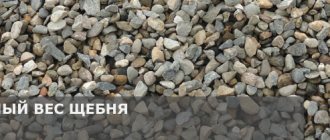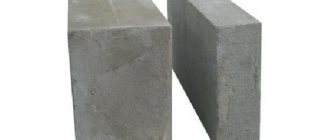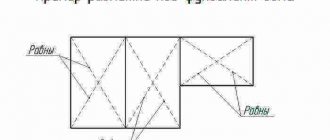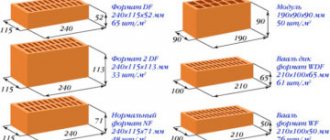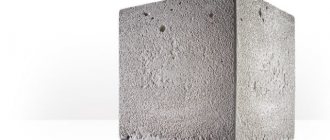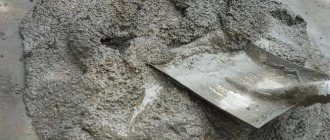The question of how much a foam block weighs is relevant for everyone who plans to carry out repair and construction work using this material. Foam blocks are made from lightweight concrete, used in private and industrial construction, valued for their strength and lightness, quick and easy installation, high level of sound insulation and heat conservation.
Foam concrete is cellular lightweight concrete, which is similar to aerated concrete, but has some differences in composition and production technology. The basis of foam concrete is cement, sand and water. Special foaming substances of synthetic or organic origin are added to the solution. They foam the mass, the structure is saturated with air bubbles, and closed pores are created during the hardening process.
Due to the pores, the density of the material and its weight are significantly reduced, and the sound/heat insulation characteristics are increased. During the construction process, it is very important to know the weight of foam concrete in order to select the appropriate type of foundation, calculate the loads, and plan the installation process.
What does the concept mean?
The weight of a concrete block is the force with which it acts on a support or other type of fastening that prevents it from falling.
It arises due to gravity and at rest is equal to the mass of the block in kg or tons. Often in construction the concept of volumetric and specific gravity is used:
- The first indicator characterizes the weight of a unit of volume, presented in the form of a solid block.
- The second is the ratio of material weight to volume, with the dimension kg/m3.
The specific gravity of the stone will depend on its fillers. Since, according to GOST 13579-78, concrete blocks are produced in various modifications, which have their own characteristics and performance quality. Externally sized blocks can have completely different weights.
Knowing the external dimensions of concrete products and their specific gravity according to GOST, it is possible to establish the standard weight.
- A, B, C – dimensions of the element;
- p — specific gravity according to GOST, kg/m3.
By comparing the standard weight with the actual weight obtained at the weighing complex when weighing a vehicle with stones, it is possible to determine how much the products actually comply with GOST, which is very important, since “light” products are defective and may not withstand the building structure
What does mass depend on?
The weight of concrete is determined by the dimensions and shape of the product, compressive strength characteristics, the specific gravity of concrete, reinforcement and filler, and the presence of auxiliary elements, for example, mounting loops.
In order to standardize the production of concrete blocks for standard construction, they are marked.
What is the size?
The weight of concrete stones is regulated by the above-mentioned GOST and depends on the categories of products. FBS is a monolithic, solid rectangular section made of high-quality concrete, with high technological characteristics and strength.
The manufacturing process does not involve reinforcement, apart from the installation of fastening loops.
Weight of FBS depending on the compression class of concrete:
- FBS 24.3.6-T, class B 7.5, specific weight of concrete m3/steel kg - 0.406/1.46, total weight - 0.97 t;
- FBS 24.6.6-T, class B 7.5, specific weight of concrete m3/steel kg - 0.679/2.346, total weight - 1.63 t;
- FBS 12.4.6-T, class B 7.5, specific weight of concrete m3/steel kg - 0.265/1.46, total weight - 0.64 t.
Relationship between various characteristics
The size of the pores (cells) is determined by the specific gravity of the concrete. In turn, all the main parameters of cellular concrete depend on their volume, volume distribution and nature. Porosity is inversely proportional to the value of this value (Table 1.)
Thermal conductivity is one of the most important characteristics of concrete. Reflects its ability to transmit thermal energy. Its value is determined directly by the density value. The combination of these parameters is the main factor on which the strength and warmth in the house depends. One of the undeniable qualities of foam concrete is low thermal conductivity (Table 2).
The strength of concrete is also directly proportional to the density value. As can be seen from Table 3, strength increases with increasing specific gravity of foam concrete. Foam blocks of various brands are used to perform different jobs. The classification of foam concrete by density is as follows. For grades D300 - D500, the strength is B0.5 - B1. Foam block with such characteristics is used as a thermal insulation material.
Grades D500 - D900 with strength B1 - B5 belong to structural and thermal insulation materials. Blocks of this class can be used to build one-story cottages. At D1000 - D1200, the corresponding strengths are B5 - B12.5. Such foam blocks are structural type blocks and can be used to build a multi-story building.
Thus, an increase in the specific gravity of foam concrete leads to an increase in its strength and thermal insulation properties. But if strength is not excessive, then the situation with thermal conductivity is not entirely clear. With a higher thermal conductivity coefficient, the material transmits heat faster. This means that it is less resistant to cold coming from outside. In other words, the house cools down faster, but the heat stays worse. From this article you will learn how to insulate a foundation.
It can be stated that density is the main quantitative characteristic of the structure of cellular concrete. As a consequence, it determines the meaning of all its technical properties. The tables given below very eloquently demonstrate the existence of a connection between such characteristics as porosity, strength, thermal conductivity and density of foam concrete.
| Density, kg/cub.m | 400 | 500 | 600 | 700 | 800 | 900 | 1000 |
| Porosity, % | 80 | 78 | 73 | 70 | 67 | 63 | 60 |
Thermal conductivity values
| Density, kg/cub.m | 400 | 500 | 600 | 700 | 800 | 900 | 1000 |
| Thermal conductivity coefficient, W/(m°C) no more (on sand) | 0,10 | 0,12 | 0,14 | 0,18 | 0,21 | 0,24 | 0,29 |
| Density, kg/cub.m | 400 | 500 | 600 | 700 | 800 | 1000 | 1100 |
| Concrete class (max) compressive strength | B 0.75 | IN 1 | B 2.5 | V 3.5 | AT 5 | B 7.5 | AT 10 |
Features of the use of aerated concrete and gas silicate blocks
When figuring out which is better - gas silicate or aerated concrete, and what is the difference between these substances, it is important to understand the features of their use. In this case, it is necessary to take into account not so much the difference in compositions, but the correct use of materials
- For laying blocks of aerated concrete and gas silicate, a special adhesive mixture is used, which, in addition to cement and sand, contains additives that improve adhesion and accelerate the setting of the binder mortar;
- Considering the increased hygroscopicity of cellular concrete, façade walls made of aerated concrete must be plastered, covered with a layer of moisture-proofing putty, or other means used to protect external walls from precipitation. To make them less wet by rain, it is necessary to install an overhanging roof;
Original decoration of aerated concrete walls with bricks and porcelain tilesSource expertfasada.ru
For insulation, painting or finishing of facades, it is necessary to use materials with good vapor permeability. At the same time, moisture will not be retained in the concrete blocks and the walls will not mold;
Video description
About whether it is possible to do without insulating walls made of aerated concrete - in the following video:
- Under aerated concrete and gas silicate blocks, waterproofing material must be laid on the foundation;
- To prevent shrinkage and destruction of the walls, during the laying of the blocks, reinforcement is made in the first and every fourth row, as well as in the area of window openings.
Reinforcement of a load-bearing wall during the construction of a house made of aerated concreteSource zaggo.ru
Deciding which is better – aerated concrete or aerated silicate for building a house, you need to take into account the type and purpose of the object being built, as well as the technology requirements.
The brand of aerated concrete or gas silicate used plays an important role.
When constructing load-bearing walls, aerated concrete products of structural grades D1000, D1200 are used.
For the construction of private houses and cottages (low-rise buildings), structural and thermal insulation material of grades D500-D900 is used.
Products of lower density (grades D300, D400) are used for additional thermal insulation (creating double walls) or for the construction of internal partitions.
Interior partitions made of aerated concrete blocksSource okvalent.com.ua
The shape of the blocks and their sizes are of great importance.
For example, for lightweight partitions, straight aerated concrete blocks measuring 150x250x625 mm are used. For monolithic walls, gas silicate U-shaped blocks with a thickness of 200-400 mm, a height of 250 mm and a length of 500 mm are more suitable.
Aerated concrete blocks of various shapesSource moydomik.net
Briefly about the main thing
When choosing competitive materials for the construction of low-rise and high-rise buildings, customers often have doubts: “gas silicate blocks or aerated concrete blocks - which is better, which are more suitable.
People compare the advantages and disadvantages of materials and focus on their technical characteristics. Take into account that gas silicate blocks are manufactured only in a factory manner and have more precise dimensions and shape.
Gas silicate has other advantages over aerated concrete (better heat and sound insulation, less hygroscopicity and shrinkage). However, price plays an important role.
Construction of objects from aerated concrete is cheaper. Considering that the difference in quality indicators is insignificant, many people prefer to buy aerated concrete blocks.
When purchasing materials, it is especially important to take into account building codes and recommendations of specialists
What does the density value depend on?
This characteristic is mainly influenced by two parameters: the degree of porosity and the volume concentration of the filler.
The role of the latter is played by sand, as well as fly ash. Fly ash is a finely dispersed material consisting of small particles. Sand is denser than ash, therefore, the greater its share in the solution, the higher the average density of foam concrete will be. The presence of another component, a foaming agent, also plays an important role. Porosity directly depends on the amount of foaming agent in the mixture. Density, on the contrary, is inversely proportional. So, for example, to obtain concrete grade D400, you need to add 0.85 kg of this substance per 1 cubic meter of solution. Material with D1200 contains only 0.45 kg of foaming agent.
Pros and cons of gas blocks
Aerated blocks are an excellent building material. They are easy to process. You can saw them with a regular hand hacksaw for metal, they drill without problems. When using blocks of sufficient density, fasteners can be screwed into them normally. The material does not burn and does not support combustion. Lightweight, warm, durable, breathable.
Aerated concrete blocks are a building material with good thermal insulation properties
Advantages of gas blocks:
- High strength with low weight. Autoclaved aerated concrete has sufficient strength that it can be used to build a two- or three-story mansion. At the same time, it is light in weight. This means that there will be less load on the foundation, which reduces the cost of its arrangement.
- Lightweight aerated concrete block. For the construction of walls, blocks with a width of 200 mm, strength grade D500 or D600 are usually used. Even gas blocks of this size - considerable width - weigh from 12 to 16 kilograms.
- Excellent thermal insulation properties. According to thermal engineering calculations, a wall made of gas blocks 200 mm thick has the same thermal resistance as a brick wall 60-70 cm thick. Despite the fact that it weighs several times less, the cost of building a house is much lower. There are also such names for this material as heat block, heat and gas block, etc.
- High geometry accuracy. If the blocks do not differ in size, masonry is easy. But this parameter very much depends on the manufacturer.
- Moisture resistance and frost resistance. Autoclaved gas blocks have good moisture resistance. These figures are much lower than those of brick, but they are more than enough to build a house.
For all its advantages, the gas block is not ideal. You should not leave the walls unfinished. But the finishing of a house made of aerated concrete must be correct. The material is breathable and hygroscopic. To prevent moisture from being trapped inside, it is necessary to correctly select the vapor permeability of finishing materials.
Disadvantages of aerated concrete blocks
The disadvantages of aerated concrete are a consequence of its advantages. For example, ease of processing. During construction, this is good. But you can also easily cut a passage in a wall made of aerated concrete with a chainsaw. Some attackers take advantage of this. The solution is to make a “burglary-resistant” finish, for example, covering the house with brick. There are other disadvantages of aerated concrete:
Aerated concrete is fragile and does not withstand bending loads well. The problem is solved by installing reinforcing belts
But it is important that there is no subsidence of the foundation. When laying gas blocks, a special glue is used, which costs a lot. The advantage is that with good block geometry, its consumption is very small - the seams are made 3 mm each.
If you build from blocks containing lime, it quickly corrodes the reinforcement
The problem is solved by using polymer rather than metal reinforcement. When using low-density gas blocks, special fasteners are needed.
The material is not bad, but you need to realistically evaluate the pros and cons of gas blocks. You can build a permanent home from them without much fear. Aerated concrete blocks are not suitable for building a bathhouse, as they are too hygroscopic. It is better not to use them to build a house in the country - the low frost resistance of the material will lead to it quickly deteriorating. Unless the house will maintain a positive temperature at all times, and the walls will be well insulated.
Product Features
The material has a lot of advantages. Below are the main ones.
Advantages of foam blocks
Walls made of such material are built very quickly.
- Favorable price, easy transportation.
- High quality material, low percentage of defects.
- Excellent thermal insulation and sound insulation properties.
- Increased strength and long service life.
- Light weight, which does not create unnecessary loads on the floors.
- Easy to install and process, minimum tools.
- The ability to quickly complete masonry due to the large size of the blocks.
- Good quality finished walls that can be plastered with almost any putty.
- Nails and self-tapping screws can be easily driven into foam blocks.
- There is no need to perform additional insulation work; a frame for finishing the walls is not necessary.
- Low solution consumption.
- No workers will be required, as almost anyone can lay the blocks themselves.
- Environmentally friendly and harmless to people and the environment.
- Non-flammable and resistant to rotting and decomposition.
Note! When doing masonry, it is advisable to purchase special glue. It is easy to use, and the consumption will be 15 kg/m 3 with a two-millimeter layer. The optimal size of the foam block for partitions is 300×600 mm. The thickness can range from 50 mm to 100 mm.
Product dimensions
Products have different sizes.
- 5x30x60 cm.
- 7.5x25x60 cm.
- 7.5×19.5×59.5 cm.
- 12.5x25x60 cm.
- 10×25×60 cm.
- 10×30×60 cm.
For partitions in the bathroom, light walls on the balcony, blocks with a thickness of 50 mm or 75 mm are well suited. It is advisable to make thicker walls from material 100 mm thick. Most companies and private enterprises make blocks to order.
If you want to make partitions from foam blocks - from foam blocks specifically to an individual order, you should contact the manufacturer in advance. It will cost a little more than finished purchased products, but you will get exactly what you need for construction.
The density of the blocks should also be selected in advance. The range is from D600 to D900.
According to strength classes, the material is divided into the following groups:
- B1.5;
- B2.0;
- B2.5;
- B3.0;
- B3.5;
- B4.0.
Moreover, the most popular categories are considered to be from one and a half to three.
Typically, partition foam blocks have a mass of 600 kg/m3, which is much less than the specific weight of brickwork (1700/1900 kg/m3). The large size of the block is also convenient because the laying speed increases several times.
Processing the material is extremely simple; a regular hacksaw is suitable for sawing. It is easy to drill holes for communications, cut out a niche, arch or recess of almost any shape. Thanks to these properties, foam blocks for partitions are very convenient to use. You can lay out a wall or structure of any arbitrary configuration, which allows you to turn the most daring decisions into reality.
Note! The structure of the product is such that there are many hollow cells inside, isolated from each other. This makes it waterproof, but at the same time, foam concrete perfectly allows steam to pass through, and the wall “breathes.” This property is similar to wood, so not only the walls, but also the completely built house has a favorable microclimate inside.
Differences between aerated concrete blocks
Differences between aerated concrete blocks 600x200x200 and other materials used in masonry.
Thanks to the pores, which make up 50% of the volume of the block, the weight of the structure and, accordingly, the pressure on the foundation are significantly reduced. Buildings of the same volume made of brick and aerated concrete will have different masses; blocks made of bricks will have a correspondingly smaller weight. For example, a block of size 650*500*500 weighs 23 kg, and a brick of the same size would weigh 60 kg, a significant difference.
Also, a house built from aerated concrete blocks will be much warmer than a house made of brick. Moreover, a brick structure must be additionally insulated, but aerated concrete does not require this. Accordingly, less money will be spent on building a house from blocks due to the lack of need for insulation.
The production of this type of material is very economical. Of course, the equipment for making blocks is quite expensive, but later in the process itself it is much cheaper than making bricks.
How many foam concrete blocks are in 1m³
The unit of measurement of concrete and aerated concrete building blocks for shipment and sale is cubic meters, and the price is also usually indicated per 1 m 3, and not per piece or specific weight. This pricing and measurement policy is more convenient because, knowing the sizes of the blocks (they are standardized and given in the GOST certificate, the most common block size is 200 x 300 x 60 mm), you can easily first of all calculate how many pieces of foam blocks will be needed for the construction buildings, and how many cubic meters of material will have to be purchased, and determine the final cost of the batch of building blocks.
What are gas silicate blocks?
Gas silicate block products are a modern building material made from the following raw materials:
- Portland cement, which is a binding ingredient;
- quartz sand introduced into the composition as a filler;
- lime involved in the gas formation reaction;
- powdered aluminum added to foam the mass.
When mixing the components, the working mixture increases in volume as a result of an actively occurring chemical reaction.
Gas silicate blocks are widely used in the construction industry
Molding containers filled with silicate mixture harden under various conditions:
- naturally at ambient temperature. The hardening process lasts 15-30 days. The resulting products are characterized by a reduced cost, but have insufficiently high strength;
- in autoclaves, where products are heated at high pressure. Steaming allows you to increase the strength characteristics and specific gravity of gas silicate products.
Blocks are divided into the following types:
- products for structural purposes. They are marked D700 and are in demand for the construction of permanent walls, the height of which is no more than three floors;
- thermal insulation and structural products. Brand D500 corresponds to these blocks. They are used for the construction of internal partitions and the construction of load-bearing walls of small buildings;
- thermal insulation products. They are characterized by increased porosity and density reduced to D400. This allows the use of gas silicate material for reliable thermal insulation of walls.
The digital index in the block markings corresponds to the mass of one cubic meter of gas silicate, indicated in kilograms. As the density of the material increases, its thermal insulation properties decrease. Products of the D700 brand are gradually replacing traditional brick, and products with a density of D400 are not inferior in thermal insulation properties to modern insulation materials.
Gas silicate blocks are superior in mechanical strength to foam concreteHow to calculate the weight of a gas block
You can calculate the weight of one unit of a gas block of the specified parameter in two ways:
- The first is to divide the weight of the packaged product by the number of pieces. For example, the net weight of a pallet with aerated concrete D500 400x250x600, specified by the manufacturer, is 1,152 kg. Quantity – 40 pieces. Dividing 1,152 by 40, we get 28.8 kg - the mass of one block.
- The second method involves dividing the weight of one cubic meter by the amount of aerated concrete per m³. For example, 1 m³ of D400 300x200x600 gas block is equal to 625 kg. In a cube – 27.77 pcs. By dividing the initial data we get: 22.5 kg – the weight of one piece.
Expert opinion Vitaly Kudryashov builder, aspiring author
Ask a Question
Note! The indicators of interest can be found in the accompanying documents or in the plastic packaging of the aerated block.
About the properties and characteristics of gas blocks
If you decide to choose aerated blocks for building a house, you should learn about the basic technical characteristics of this material. This way you will avoid unnecessary financial costs and make the right choice.
As the density of the aerated block increases, the safety margin increases
Dimensional characteristics. The sizes of blocks can be very different, thanks to this, their required number can be calculated as accurately as possible. The most popular are: 60x30x20, 50x40x30, 60x30x25, 40x40x30, 40x30x20, 60x40x30, 60x30x30 and 40x30x30 cm. If you know the dimensions in advance, you can accurately calculate the number of blocks in the cubometer and how many of them are required to work in accordance with the indicated technical parameters.
Density indicators. To measure the density brand, the unit in kg/m³ is used. We also note that there is GOST 25485-89, in accordance with the provisions of which gas blocks, according to density indicators, are structural, thermal insulating and structural-thermal insulating. Load-bearing capacity depends directly on the density of the material.
The photo shows the difference between materials with different specific densities
Strength. In other words, this is the maximum axial pressure that a particular gas block can withstand. For example, class B2.5 material can be used for the construction of load-bearing walls whose height is no more than 20 m.
Table No1. Comparison of aerated concrete with other building materials.
| Name | Speed of wall construction, hour/sq.m. | Wall thickness according to standards, m | Frost resistance (in cycles) | Moisture absorption,% | Thermal conductivity, W/(m*K) | Average density, kg/m3 | Compressive strength, kg/sq.m. |
| Gas blocks | 0,88 | 0,4 | 25 | Over 30 | 0,1 | 400 | 15-30 |
| Ceramic blocks | 1,3 | 0,38 | 50 | 12 | 0,21 | 830 | 128 |
| Sand-lime brick | More than 3 | 0,52 | 35 | 13 | 0,95 | 1750 | 150 |
| Ceramic brick | More than 3 | 0,52 | 35 | 13 | 0,4 | 1350 | 125 |
Thermal conductivity. Can vary from 0.096 to 0.17, indicating how much a warm room will “share” thermal energy with a cold one. Heat transfer will directly depend on this coefficient. When choosing the appropriate value, it is necessary to take into account, first of all, the humidity level.
Sectional view of an aerated concrete wall: gas-filled pores are visible, thanks to which heat is retained. Comparison of the thermal efficiency of different materials.
Frost resistance. The characteristic is measured in cycles and can vary between 25-100. As an example: for brick this indicator is no more than 50 cycles.
Shrinkage after drying. The characteristic is measured in mm/m; in this case, it should be a maximum of 0.5, otherwise many more cracks will appear on the walls of the house than is allowed by regulatory documents.
Aerated concrete blocks are fastened together either with a special adhesive for aerated concrete or with cement mortar. Mortar joints
How much does a foam block weigh: studying the dependence of mass on the type of product
Weight of a standard product according to density and size
Knowing the weight of a building material is often simply necessary. This is connected both with the transportation of cargo and its unloading; the mass of the block is important when planning the structure, or, more precisely, the type of future foundation.
That is why in this article we will touch on this topic and find out: how much does a foam block weigh? After all, the fact that it has a small mass is known to many, but not everyone can name the exact digital values.
Foam concrete composition
A foam concrete block is a breathable material that creates the same microclimate in a room as wood. The foam concrete mixture, according to GOST 25485-89 “Cellular concrete”, consists of the following components:
- The cement-binder mixture is Portland cement, manufactured according to GOST 10178-85, with a calcium silicate content of up to 70-80%.
- Sand must meet the requirements of GOST 8736-93, with a quartz content of at least 75%, clay and silt inclusions of no more than 3%.
- Water with technical requirements according to GOST 23732-79.
- A foaming agent is used based on:
- bone glue that meets the requirements of GOST 2067-93.
- pine rosin - according to GOST 19113-84.
- hide glue - according to GOST 3252-80.
- scrubber paste - according to TU 38-107101-76.
- technical caustic soda - according to GOST 2263-79.
Foaming agent
Foaming agents for foam concrete blocks, depending on the composition, can be natural or synthetic. Natural foaming agents, as the name suggests, have a natural, environmentally friendly base; the products have a thicker partition between the pores, which increases strength. Synthetic foaming agents have a hazard class of 4 and are harmful to human health; the products are inexpensive, of lower quality and less durable.
Some manufacturers began to use other components for the production of foam concrete blocks:
- Polypropylene fiber fiber VSM (construction fiber, micro-reinforcing). The use of VSM allows you to obtain a product with precise, non-destructive edges, and increase its compressive strength by up to 25%.
- Fly ash. This is ash that is formed during the combustion of solid fuel at thermal power plants. It is a finely dispersed material, with particle sizes ranging from fractions of a micron to 0.14 mm. Its use leads to the creation of a denser and harder interpore wall and a 30% saving in cement.
Table of proportions of components of the composition of popular brands D600 and D800:
Advantages and disadvantages
Aerated concrete has many more advantages than disadvantages. Thus, its light weight allows you to build houses on light foundations and in areas with weak soil. High thermal insulation makes it possible to build warm, comfortable buildings without a complex insulation system. Despite their light weight, the blocks are quite large in size.
It is also worth noting that, like stone, the gas block is not subject to combustion, is not subject to corrosion and rotting, and is not destroyed by harmful insects. In addition, the porosity of the material guarantees self-ventilation of rooms in the house (as in wooden buildings). Provided that both the exterior and interior decoration will also be “breathable”.
The ideal geometry of the blocks allows masonry to be carried out using special glue and a very thin seam to be obtained. And this, in turn, reduces the number of “cold bridges” through which heat escapes from the premises during the heating season.
If the technology is followed, the thickness of the masonry joint between aerated concrete blocks is minimalSource superfb.site
An important advantage is the ease of processing of gas blocks. Thanks to this property, it is possible to build complex buildings and individual structures by adjusting the blocks to the desired shape. Another advantage that stands out about aerated blocks is that the sizes of the blocks are different, allowing you to choose the right one for a specific type of building.
Disadvantages of aerated concrete:
- The foundation for a house must be as stable as possible, since vibrations can cause aerated concrete walls to crack. However, this drawback can be eliminated by correctly selecting the material by brand and size.
- When hanging heavy structures (plumbing fixtures, furniture, etc.) on walls, it is necessary to use special dowels and other holding hardware.
- The compressive strength is not high enough, so when building large mansions it is necessary to provide additional reinforcement to the walls.
Strengthening an aerated concrete wallSource stroim-dom.net
Tips for using foam blocks
This infographic shows the features and nuances of masonry made of foam blocks.
Tip 1
Since foam concrete blocks on the edges are quite easy to damage, try to unload them carefully. It is better to place them not on a standard solution (although this is also possible for them), but on a special glue that has a cement base
Its layer (only 2 or 3 millimeters) will be much thinner than a layer of ordinary cement mortar, and cold bridges will not appear. But thick seams between the blocks will inevitably release some of the heat outside.
Tip 2. Walls made of foam concrete must be lined. Do not believe manufacturers who claim otherwise - they lie shamelessly. Rain, snow, winds and hurricanes will gradually destroy foam concrete if it is not protected by anything. The facing material may well be plaster (both ordinary and mineral), as well as material used for ventilated facades. As for the plaster, you will need to lay a mesh underneath it, securing it to the wall made of foam concrete.
Tip 3. When facing foam blocks with bricks, be sure to leave an air gap - after all, these materials have different air permeability. If they fit tightly, water vapor will not be able to break through the brick cladding. They will be reflected from it, pass back through the foam concrete and return to the house. This should not be allowed.
Advantages and disadvantages
The construction of houses from gas silicate blocks is quite justified by the low cost of the material and its many advantages:
- Blocks intended for building houses are highly durable. For a material with an average density of 500 kg/m³, the mechanical compression rate is 40 kg/cm3.
- The low weight of gas silicate products allows you to avoid additional costs when delivering and installing blocks. The cellular material is five times lighter than ordinary concrete.
- Due to good heat transfer, heat energy consumption is reduced. This property allows you to significantly save on heating the building.
- High sound insulation rate. Due to the presence of pores, the cellular material protects against noise penetration into the building ten times better than brick.
- Good environmental properties. The blocks do not contain toxic substances and are completely safe to use. In many environmental indicators, gas silicate is equal to wood.
- The high vapor permeability of the products allows you to create good microclimate conditions in the room.
- Non-flammable material prevents the spread of fire in the event of a fire.
- The exact proportions of the block sizes make it possible to make even wall laying.
- Affordable price of material. With good technical indicators, the price of gas silicate blocks is relatively low.
A house made of gas silicate blocks allows you to significantly save on heating.
Along with a considerable number of advantages, the porous material has some disadvantages:
- The mechanical strength of blocks is slightly lower than that of reinforced concrete and brick. Therefore, when driving nails into the wall or screwing in dowels, the surface easily crumbles. The blocks hold heavy parts quite poorly.
- Moisture absorption ability. Gas silicate absorbs water well and quickly, which, penetrating into the pores, reduces the strength of the material and leads to its destruction. When constructing buildings from various types of porous concrete, surfaces are protected from moisture. It is recommended to apply plaster on walls in two layers.
- The frost resistance of blocks depends on the density of the products. Gas silicate grades below D 400 are not able to withstand a cycle of 50 years.
- The material is prone to shrinkage. Therefore, especially for blocks of grades below D700, the first cracks may appear a couple of years after the construction of the building.
When decorating walls made of gas silicate, gypsum plaster is mainly used. It perfectly hides all the seams between the blocks. Cement-sand mixtures are not retained on a porous surface, and when the air temperature drops, small cracks form.
The popularity of gas silicate is increasing every year. Cellular blocks have almost all the qualities necessary for the effective construction of low-rise buildings. Some characteristics far exceed those of other materials. Using lightweight gas silicate blocks, you can build a reliable building at low cost in a relatively short time.
How much does a foam block cost per piece?
Prices for foam blocks
| FOAM BLOCK SIZES | Quantity per 1m³ pcs | PRICE per piece |
| D600 10-30-60 cm (100-300-600 mm) | 55,56 | RUB 92.70 |
| D600 12-30-60 cm (120-300-600 mm) | 46,3 | RUB 111.20 |
| D600 15-30-60 cm (150-300-600 mm) | 37,04 | RUB 135.80 |
| D600 20-30-60 cm (200-300-600 mm) | 27,78 | RUB 180.00 |
Rating of companies in Russia
The rating is determined based on the results of purchases of aerated concrete; as a rule, it is conducted by large trading platforms covering all regions of Russia. The rating takes into account such key indicators as: brand of aerated concrete, price, characteristics and logistics of cargo with delivery and unloading at the construction site.
In accordance with the brand and standard sizes, aerated concrete has distinctive characteristics in terms of density, fire resistance and thermal conductivity. The density of the block is directly related to its strength. The more cement a product contains, the more durable it is, and, consequently, the colder, since concrete conducts thermal energy well. Aerated concrete is marked by density, for example, for D500 it is 500 kg/m3.
A comparison of block characteristics is shown in the table.
| № | Manufacturer aerated concrete blocks | A country | Model | Price per 1 m3 | Advantages | Flaws |
| 1 | AEROC | Russia, 2004 | D500/400/300 625x200x250 625x375x250 625x400x250 | 4750 |
| Not detected |
| 2 | YTONG | Russia, 2007 | 625x250x200 625x250x75 625 x 250 x 375 | 3900 |
| Low moisture resistance |
| 3 | LSR | Russia, 2010 | D300 (B2.0) D400 (B2.5) D500 D600 (B5.0) U-blocks | 4650 |
| Small assortment |
| 4 | EURO-AIR CONCRETE | Russia, 2008 | D500/400/300 625x200x250 625x375x250 625x400x250 | 3300 |
| Loose porous structure |
| 5 | Lipetsk Silicate Plant | Russia, 2015 | D500/400/300 V1.5-V3.5 | 3100 |
| There are blocks with quality deviations |
| 6 | Main-Sibirskstroy (SIBIT) | Russia, 2007 | B2-D600-B2.5 625/200/250 625/240/250 625/400/250 | 4900 |
| High hygroscopicity |
| 7 | Saratov building materials plant | Russia, 2010 | D500/400/300 625x200x250 625x375x250 625x400x250 | 3200 |
| Lots of fighting when transporting blocks |
| 8 | Kostroma silicate plant | Russia, 1930 | D500/400/300 600x300x200 600x300x100 600x250x400 600x250x300 | 3900 |
| High percentage of deviation in dimensions up to 2% |
Calculates mass independently
Now it's time to learn how to do calculations. In fact, there is nothing difficult about this and anyone can cope with this task.
We take into account the sorption mass
How to correctly calculate the weight of a block under operating or holiday humidity conditions?
The instructions are extremely simple:
- The first step is to calculate the volume of one product. Let its size be 625*400*300. 0.625*0.4*0.3=0.075 m3.
- Now we multiply the volume and density of the block, let’s say it is equal to D400. 0.075*400=30 kg.
- Next, we need to find out which raw material acted as the silica component. There can be 2 options: ash or sand. If it is sand, then the humidity level is usually about 15-20%. If it is ash, then slightly less, about 12-15%.
- Next, we calculate the mass of moisture that the product could absorb.
- To do this, you need to multiply the minimum humidity indicator and the mass of the dry block: 30 * 15% = 4.5 kg.
- Finally, we add up the results: 4.5 + 30 = 34.5 kg. This is the mass of the block taking into account sorption moisture.
Product cube weight
If we talk about the weight of a cube of foam blocks, then, in this case, everything is even simpler. We have already said above that the net weight of a product in a dry state is determined by the formula: volume * density. That is, if we want to know the weight of a cubic meter, then we don’t have to count anything.
1 m3 of foam block, with a density of 500 kg/m3, weighs 500 kg, with a density of 1000 kg/m3 - 1000 kg, and so on.
The density of the foam concrete block can vary from 300 to 1200 kg/m3. This means that a cube of products cannot weigh more than 1200 kg, again, in a dry state.
Number of blocks of different sizes in a cube
Weight of one pallet with products
- In order to calculate the weight of one pallet of products, we need to find out the number of blocks that are located in the pallet.
- Only then will we be able to determine the mass by adding the additional weight of the pallet to the weight of the blocks.
- A plastic pallet can weigh from 10 to 15 kg, and a wooden pallet - up to 30 kg.
- Different manufacturers have different numbers of blocks that fit on a pallet.
- Let's assume that we have 2.0 m3 of blocks on a pallet, measuring 625*400*250.
- 1 such block weighs: 0.625*0.4*0.25=0.0625 m3; 0.0625*500=31.25; 2/0.0625=32 pieces. 32*31.25=1000 kg. 1000 kg + 30 kg = 1030 kg.
Composition and production technology of gas silicate blocks
The mixture for the production of gas silicate blocks has the following composition:
- binder (Portland cement according to GOST 10178-76, calcium lime (according to GOST 9179-77);
- silicate or siliceous filler (quartz sand with 85% quartz content, fly ash, etc.);
- lime, with a content of magnesium and calcium oxides of more than 70%, and a slaking speed of up to 15 minutes;
- technical water;
- gas-forming additive (aluminum powder and others).
Gas silicate belongs to the class of lightweight cellular concrete. This material is a mixture consisting of 3 main components: cement, water and fillers. Lime and quartz sand in a ratio of 0.62:0.24 can act as fillers. We should also talk about the additives that give gas silicate its individual characteristics. Fine aluminum powder acts as an additive. All these components are thoroughly mixed, and under certain conditions, foaming of all these materials occurs. When aluminum powder reacts with lime, hydrogen is released. The huge number of hydrogen bubbles released makes up the porous structure, which is the main distinguishing feature of gas silicate. Its structure resembles a concrete “sponge”, since the entire volume of the block consists of cells (bubbles with a diameter of 1-3 mm).
Gas silicate blocks
The cellular structure makes up almost 85% of the volume of the entire block, so this material is very light in weight. First, a mixture of components is prepared in a special mixer for 5 minutes, which includes Portland cement, fine sand (quartz), water, lime and a gasifier (most often, this is an aluminum suspension). Hydrogen produced by the reaction between aluminum paste (powder) and lime forms pores. Bubbles ranging in size from 0.6 to 3 mm are evenly distributed throughout the material.
Basic chemical reactions take place in metal containers or molds. The mixture is subjected to vibration, which promotes swelling and setting. After hardening, all surface irregularities are removed with a steel string. The formation is divided into blocks, and then they are sent to an autoclave unit. The final calibration of the finished blocks is carried out by a milling machine.
Gas silicate blocks are manufactured only using the autoclave method. Aerated concrete blocks can be produced both by autoclave and non-autoclave methods (natural hardening of the mixture):
- Autoclave processing. This stage significantly improves the technical characteristics of gas silicate. Here, steam treatment is carried out for 12 hours at high pressure, the temperature of which is almost 200°C. This heating process makes the texture more uniform, thereby improving the strength properties (at least 28 kgf/m²). Its thermal conductivity is 0.09-0.18 W (m∙K), which makes it possible to erect walls in one row (400 cm) in almost any climatic conditions, but excluding the northern regions.
- Non-autoclave technology. It consists in the natural hardening of the mixture: moistening and drying under natural conditions. In this case, it is quite possible to do it yourself, since no special equipment is required. The strength of blocks in such production does not exceed 12 kgf/m².
The first type is more expensive. This is due to significant manufacturing costs, as well as the best technical characteristics of gas silicate blocks produced by this method. They are much stronger, their thermal conductivity coefficient is lower. The pores inside such gas silicate are distributed extremely evenly, which affects the precise compliance of the material with the specified parameters.
What are the requirements?
Wall stones of this modification are made of heavy concrete, guaranteeing high strength characteristics. However, due to its weight, this type is not suitable for certain types of foundations, and in some cases they are produced hollow.
The decision to choose a specific type of foundation and wall stones is made by the design organization, taking into account:
- Location of groundwater.
- Soil characteristics in the building area.
- Stress values from the wall structure.
- Soil freezing level.
- Presence of a basement and utilities.
- Estimated service life of the structure.
The best foundation for concrete blocks is considered to be a strip foundation. The standard size is 40x20x20 cm, it is additional to the dimensions of the foundation, while they differ in design and weight:
- Solid (solid), p=2250 kg/m3, 36 kg;
- double-hollow, p=1530 kg/m3, 17 kg;
- three-hollow, p=1670 kg/m3, 20 kg;
- four-slit, p=1260 kg/m3, 20 kg;
- semi-slit, p=1450 kg/m3, 22 kg.
Types and sizes of gas silicate blocks
The weight, dimensions of gas silicate blocks and their other parameters are determined by GOSTs 21520-89 and 31360-2007. These standards provide general tables for all similar products made of cellular concrete. Moreover, the standardized sizes of foam blocks and gas silicate building materials with similar properties differ greatly in numbers.
For the first foam concrete option, the standards indicate ten standard sizes from 88x200x398 to 188x300x588 mm. Wall blocks as such do not have standard GOST dimensions.
For them there are only maximum values:
- Height no more than 500 mm.
- Width (thickness) up to 500 mm.
- Length no more than 625 mm.
However, manufacturers often produce gas silicate according to specifications. The size in this case can be anything. For example, products for partitions in a house are most often made in the form of thin slabs with parameters 100x250x600. And analogues for external walls usually have dimensions of 300x250x625.
Much in terms of size depends on the manufacturer and the equipment he has for cutting aerated concrete into individual blocks. The comparative table below shows some options for such products, indicating density, frost resistance and other characteristics.
Table of sizes and characteristics of wall gas silicate
| Brand | Length | Width | Heightmm | Density kg/cube m | Frost resistance | Thermal conductivity |
| D-400 | 600 | 200/250/350/375/400 | 200/250 | B2 | F100 | 0,1 |
| D-500 | 600 | 200/250/350/375/400 | 200/250 | B2.5 | F100 | 0,12 |
| D-600 | 600 | 200/250/350/375/400 | 200/250 | B3.5 | F100 | 0,12 |
Some product classifications
When looking for an answer to the question of how much 1 foam block weighs, as you already understand, you should pay attention to the average density indicator. This indicator formed the basis of the classification and predetermined the scope of application of the products.
Varieties of products according to scope of application
And now in more detail:
- The least dense products are called thermal insulation and not by chance. The fact is that the value of this brand is only sufficient so that the blocks can withstand their own weight.
They are used for thermal insulation, since their thermal efficiency is relatively high. They have minimal weight. Most often, low-density foam concrete is used in liquid form.
Application of monolithic thermal insulating foam concrete
- A block characterized by a density of D500-900 is called structural and thermal insulation. Its weight can vary from 9 to 30 - 35 kg. Despite the higher strength values, the block can safely be called warm, because its thermal conductivity coefficient does not exceed 0.22 - 0.23 W*mS.
- Products called structural are the densest, and therefore the heaviest, of all the above types. Their thermal conductivity is also increased. Weight can reach 48 kg, and, taking into account operating humidity, even 50 - 51 kg.
Structural foam block, photo
Note! Foam blocks may also differ in manufacturing technology and composition. First of all, this applies to products made by hand and in a factory. Due to incorrect dosing of components and lack of technological control, for example, a block produced at home may turn out to be heavier while maintaining a low strength index.
Characteristics of foam blocks of various densities
Purpose of the block
Foam block, in accordance with its purpose, can be: wall and partition:
- The wall block, as a rule, is more durable, has larger dimensions and, accordingly, weight. This block is usually used in the construction of walls. Standard sizes are: 625 (600) * 300 * 200, 625 (600) * 300 * 250, 625 (600) * 400 * 250, 600 (625) * 500 * 300.
- Partition products are used in the construction of partitions. Their length and height are usually 600 (625) m and 250 mm, respectively. But the width is 80, 100, 90, 120, 150 mm.
Of course, other sizes of products can be produced, and GOST does not prohibit this. However, over time, those block sizes that are in greatest demand have been established experimentally.
This, of course, is also explained by the design documentation, in which such products are most often found.
Weight of standard size blocks
Let’s use the table and visually study the dimensions and weight of the foam block.
Table 1. Foam blocks: dimensions and weight:
| Brand of product by density, D | Foam block weight 600x300x200 | Foam block weight 600x250x100 | Foam block weight 600x300x100 | Foam block weight 625x400x250 | Foam block weight 625x300x250 |
| D500 | About 20 kg | 8 kg | 8 kg | 25 - 27 kg | 22 – 24 kg |
| D800 | 28 – 35 kg | — | — | 36 – 39 kg | 29 – 34 kg |
| D600 | 22 - 26 kg | — | 16 kg | 30 – 32 kg | 26 – 28 kg |
| D1000 | 35 - 38 kg | — | — | 40 – 45 kg | 36 – 40 kg |
| D1200 | Up to 42 kg | — | — | 47 kg | Up to 45 kg |
